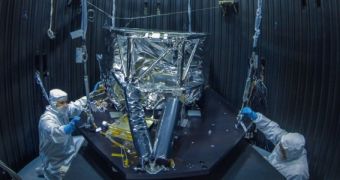When the James Webb Space Telescope (JWST) launches into space, no earlier than 2018, it will be the largest, most complex and most expensive observatory ever created. Each of its scientific instruments have to meet extreme specifications and mission requirements, and NASA has to make sure that all of its conditions are adhered to before the telescope launches.
As such, it stands to reason that even the smallest systems and subsystems are checked ferociously for any signs of weakness. In the image above, we see the Shield Environmental Test Unit for the Mid-Infrared Instrument (MIRI) being lowered into a test chamber at the NASA Goddard Space Flight Center, in Greenbelt, Maryland.
GSFC technicians Tony Kiem (left) and George Mooney position the shield using a special crane. The component, which will be responsible for keeping MIRI at optimum temperatures during the actual mission, is about to begin its cryogenic testing at the NASA installation.
JWST is destined to replace the NASA/ESA Hubble Space Telescope as the American space agency's flagship observatory in space. It will be the first optical telescope to go to space in a folded configuration, and open upon arrival at its designated location.

 14 DAY TRIAL //
14 DAY TRIAL //